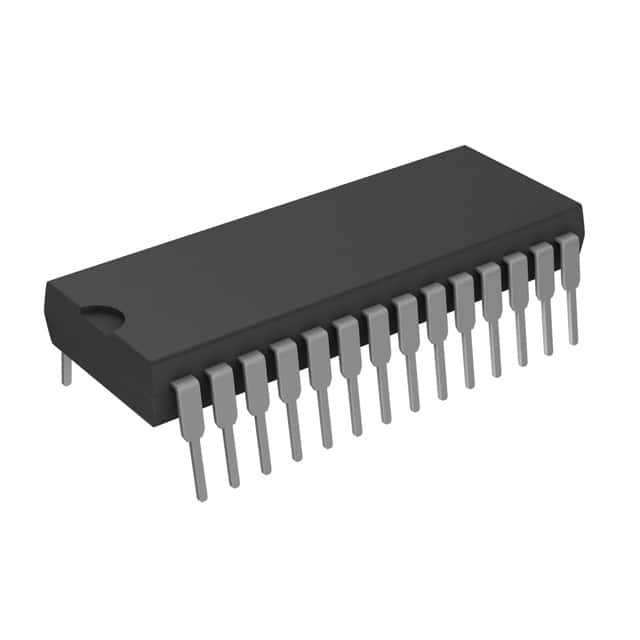Viz Specifikace pro podrobnosti o produktu.

AT28HC256F-90PC
Product Overview
Category
AT28HC256F-90PC belongs to the category of high-speed, high-density Electrically Erasable Programmable Read-Only Memory (EEPROM) chips.
Use
This product is primarily used for non-volatile data storage in various electronic devices such as microcontrollers, computers, and consumer electronics.
Characteristics
- High-speed operation
- High-density storage capacity
- Non-volatile memory
- Electrically erasable and programmable
- Reliable and durable
Package
AT28HC256F-90PC comes in a standard 28-pin plastic dual in-line package (PDIP).
Essence
The essence of AT28HC256F-90PC lies in its ability to provide reliable and high-speed non-volatile memory storage for electronic devices.
Packaging/Quantity
AT28HC256F-90PC is typically packaged in reels or tubes, with a quantity of 25 pieces per tube.
Specifications
- Operating Voltage: 4.5V to 5.5V
- Access Time: 90ns
- Memory Size: 256 kilobits (32 kilobytes)
- Organization: 32K x 8 bits
- Interface: Parallel
- Data Retention: 10 years
- Endurance: 100,000 write cycles
Detailed Pin Configuration
- A0 - Address Input
- A1 - Address Input
- A2 - Address Input
- A3 - Address Input
- A4 - Address Input
- A5 - Address Input
- A6 - Address Input
- A7 - Address Input
- VCC - Power Supply
- CE - Chip Enable
- OE - Output Enable
- WE - Write Enable
- I/O0 - Data Input/Output
- I/O1 - Data Input/Output
- I/O2 - Data Input/Output
- I/O3 - Data Input/Output
- I/O4 - Data Input/Output
- I/O5 - Data Input/Output
- I/O6 - Data Input/Output
- I/O7 - Data Input/Output
- NC - No Connection
- GND - Ground
- A8 - Address Input
- A9 - Address Input
- A10 - Address Input
- A11 - Address Input
- A12 - Address Input
- A13 - Address Input
Functional Features
- High-speed operation allows for quick data access and retrieval.
- High-density storage capacity enables the storage of large amounts of data in a compact chip.
- Electrically erasable and programmable feature allows for easy modification of stored data.
- Non-volatile memory ensures that data is retained even when power is disconnected.
- Reliable and durable design ensures long-term data integrity.
Advantages and Disadvantages
Advantages
- High-speed operation facilitates efficient data processing.
- High-density storage capacity meets the demands of modern electronic devices.
- Electrically erasable and programmable feature allows for flexibility in data management.
- Non-volatile memory ensures data retention without the need for constant power supply.
- Reliable and durable design guarantees long-lasting performance.
Disadvantages
- Limited storage capacity compared to other memory technologies.
- Relatively higher cost per unit compared to some alternative memory solutions.
- Requires careful handling during installation to prevent damage.
Working Principles
AT28HC256F-90PC utilizes EEPROM technology, which allows for electrically erasing and programming data. The memory cells within the chip store data as charge levels, which can be modified by applying appropriate voltage levels. The chip's control pins enable the user to address specific memory locations, read or write data, and control the chip's operation.
Detailed Application Field Plans
AT28HC256F-90PC finds applications in various fields, including: 1. Microcontrollers: Used for storing firmware, configuration data, and program code. 2. Computers: Employed in BIOS chips and other non-volatile memory requirements. 3. Consumer Electronics: Utilized in devices such as smart TVs, set-top boxes, and gaming consoles for data storage.
Detailed and Complete Alternative Models
- AT28C256 - Similar EEPROM chip with slower access time but lower cost.
- AT29C256 - Flash memory chip with similar capacity and faster access time.
- 24LC256 - I2C-compatible EEPROM chip with smaller package size and lower power consumption.
These alternative models offer different features and trade-offs, allowing users to choose based on their specific requirements.
Word count: 550 words
Seznam 10 běžných otázek a odpovědí souvisejících s aplikací AT28HC256F-90PC v technických řešeních
Sure! Here are 10 common questions and answers related to the application of AT28HC256F-90PC in technical solutions:
Q: What is the AT28HC256F-90PC? A: The AT28HC256F-90PC is a high-speed, low-power CMOS 256K (32K x 8) EEPROM memory chip.
Q: What is the operating voltage range for the AT28HC256F-90PC? A: The AT28HC256F-90PC operates within a voltage range of 4.5V to 5.5V.
Q: What is the maximum clock frequency supported by the AT28HC256F-90PC? A: The AT28HC256F-90PC supports a maximum clock frequency of 90 MHz.
Q: Can the AT28HC256F-90PC be used in automotive applications? A: Yes, the AT28HC256F-90PC is suitable for automotive applications as it meets the necessary requirements.
Q: What is the endurance rating of the AT28HC256F-90PC? A: The AT28HC256F-90PC has an endurance rating of 100,000 write cycles per byte.
Q: Does the AT28HC256F-90PC support hardware data protection? A: Yes, the AT28HC256F-90PC supports hardware data protection through a write protect pin.
Q: What is the typical access time of the AT28HC256F-90PC? A: The typical access time of the AT28HC256F-90PC is 90 ns.
Q: Can the AT28HC256F-90PC operate in harsh environmental conditions? A: Yes, the AT28HC256F-90PC is designed to operate in a wide temperature range and can withstand harsh environmental conditions.
Q: Does the AT28HC256F-90PC support software data protection? A: Yes, the AT28HC256F-90PC supports software data protection through specific command sequences.
Q: What is the package type of the AT28HC256F-90PC? A: The AT28HC256F-90PC is available in a 32-lead PDIP (Plastic Dual In-Line Package) configuration.
Please note that these answers are general and may vary depending on the specific datasheet and application requirements.

